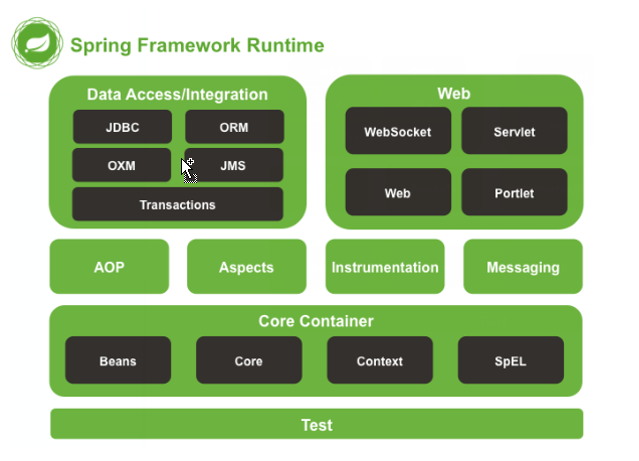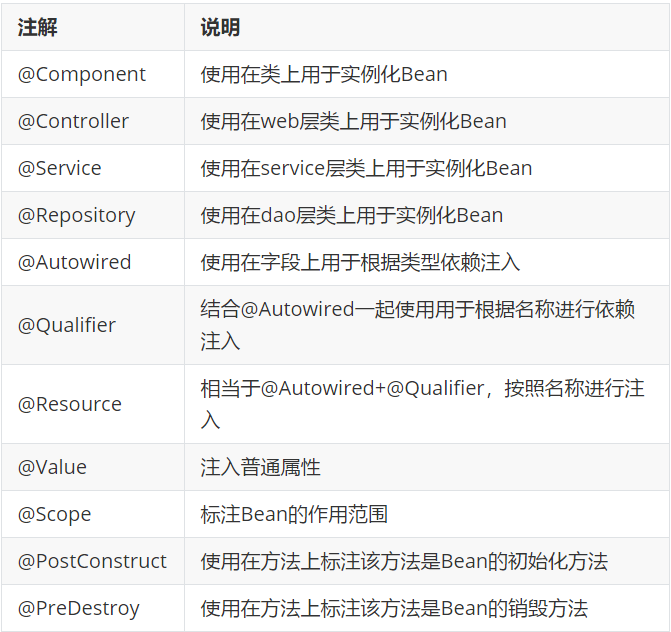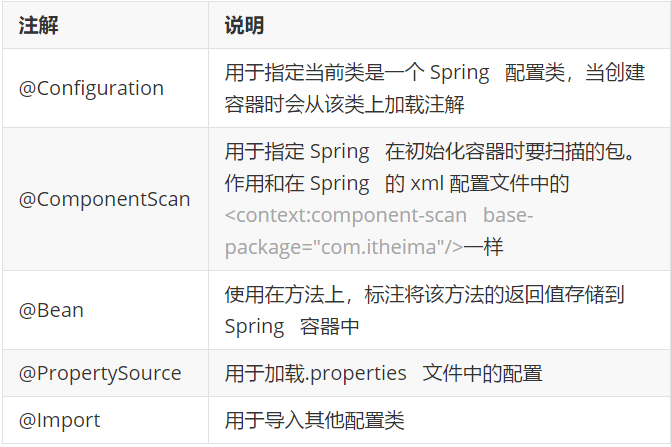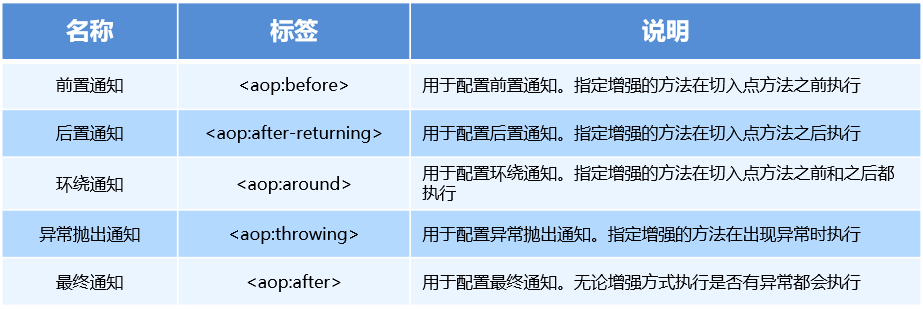目录
⑤在 applicationContext.xml 中配置织入关系
一、概述
1.1 spring的概念与使用
Spring是什么?
Spring是分层的 Java SE/EE应用 full-stack 轻量级开源框架,以 IoC(Inverse Of Control:反转控制)和AOP(Aspect Oriented Programming:面向切面编程)为内核。
提供了展现层 SpringMVC和持久层 Spring JDBCTemplate以及业务层事务管理等众多的企业级应用技术,还能整合开源世界众多著名的第三方框架和类库,逐渐成为使用最多的Java EE 企业应用开源框架。
Spring的优势?
方便解耦,简化开发
AOP 编程的支持
声明式事务的支持
方便程序的测试
1.2 spring的体系结构

1.3 spring的快速入门(基础使用)
Spring程序开发步骤
①导入 Spring 开发的基本包坐标
②编写 Dao 接口和实现类
③创建 Spring 核心配置文件
④在 Spring 配置文件中配置 UserDaoImpl
⑤使用 Spring 的 API 获得 Bean 实例
①导入Spring开发的基本包坐标
pom.xml
<properties>
<spring.version>5.0.5.RELEASE</spring.version>
</properties>
<!--导入spring的context坐标,context依赖core、beans、expression-->
<dependencies>
<dependency>
<groupId>org.springframework</groupId>
<artifactId>spring-context</artifactId>
<version>${spring.version}</version>
</dependency>
</dependencies>②编写 Dao 接口和实现类
public interface UserDao {
public void save();
}
public class UserDaoImpl implements UserDao {
@Override
public void save() {
System.out.println("UserDao save method running....");
}
}③创建 Spring 核心配置文件
在类路径下(resources)创建applicationContext.xml配置文件
<?xml version="1.0" encoding="UTF-8" ?>
<beans xmlns="http://www.springframework.org/schema/beans" xmlns:xsi="http://www.w3.org/2001/XMLSchema-instance"
xsi:schemaLocation="
http://www.springframework.org/schema/beans http://www.springframework.org/schema/beans/spring-beans.xsd">
</beans>
④在 Spring 配置文件中配置 UserDaoImpl
<?xml version="1.0" encoding="UTF-8" ?>
<beans xmlns="http://www.springframework.org/schema/beans" xmlns:xsi="http://www.w3.org/2001/XMLSchema-instance"
xsi:schemaLocation="
http://www.springframework.org/schema/beans http://www.springframework.org/schema/beans/spring-beans.xsd">
<bean id="userDao" class="com.itheima.dao.impl.UserDaoImpl"></bean>
</beans>
⑤使用 Spring 的 API 获得 Bean 实例
@Test
public void test1(){
ApplicationContext applicationContext = new
ClassPathXmlApplicationContext("applicationContext.xml");
UserDao userDao = (UserDao) applicationContext.getBean("userDao"); userDao.save();
}1.4 Spring配置数据源(数据库连接池)
数据源(连接池)的作用开发步骤
数据源(连接池)是提高程序性能如而出现的
事先实例化数据源,初始化部分连接资源
使用连接资源时从数据源中获取
使用完毕后将连接资源归还给数据源
常见的数据源(连接池):DBCP、C3P0、BoneCP、Druid等
开发步骤
①导入数据源的坐标和数据库驱动坐标
<!-- C3P0连接池 --> <dependency> <groupId>c3p0</groupId> <artifactId>c3p0</artifactId> <version>0.9.1.2</version> </dependency> <!-- Druid连接池 --> <dependency> <groupId>com.alibaba</groupId> <artifactId>druid</artifactId> <version>1.1.10</version> </dependency><!-- mysql驱动 --> <dependency> <groupId>mysql</groupId> <artifactId>mysql-connector-java</artifactId> <version>5.1.39</version> </dependency>
②创建数据源对象创建C3P0连接池
@Test public void testC3P0() throws Exception { //创建数据源 ComboPooledDataSource dataSource = new ComboPooledDataSource(); //设置数据库连接参数 dataSource.setDriverClass("com.mysql.jdbc.Driver"); dataSource.setJdbcUrl("jdbc:mysql://localhost:3306/test"); dataSource.setUser("root"); dataSource.setPassword("root"); //获得连接对象 Connection connection = dataSource.getConnection(); System.out.println(connection); }创建Druid连接池
@Test public void testDruid() throws Exception { //创建数据源 DruidDataSource dataSource = new DruidDataSource(); //设置数据库连接参数 dataSource.setDriverClassName("com.mysql.jdbc.Driver"); dataSource.setUrl("jdbc:mysql://localhost:3306/test"); dataSource.setUsername("root"); dataSource.setPassword("root"); //获得连接对象 Connection connection = dataSource.getConnection(); System.out.println(connection); }
③设置数据源的基本连接数据jdbc.driver=com.mysql.jdbc.Driver jdbc.url=jdbc:mysql://localhost:3306/test jdbc.username=root jdbc.password=root
④使用数据源获取连接资源和归还连接资源@Test public void testC3P0ByProperties() throws Exception { //加载类路径下的jdbc.properties ResourceBundle rb = ResourceBundle.getBundle("jdbc"); ComboPooledDataSource dataSource = new ComboPooledDataSource(); dataSource.setDriverClass(rb.getString("jdbc.driver")); dataSource.setJdbcUrl(rb.getString("jdbc.url")); dataSource.setUser(rb.getString("jdbc.username")); dataSource.setPassword(rb.getString("jdbc.password")); Connection connection = dataSource.getConnection(); System.out.println(connection); }
二、Spring的注解开发与整合
2.1 Spring原始注解
Spring是轻代码而重配置的框架,配置比较繁重,影响开发效率,所以注解开发是一种趋势,注解代替xml配置文件可以简化配置,提高开发效率。
Spring原始注解主要是替代<Bean>的配置:

注意:
使用注解进行开发时,需要在applicationContext.xml中配置组件扫描,作用是指定哪个包及其子包下的Bean需要进行扫描以便识别使用注解配置的类、字段和方法。
必须要有的组件扫描(没有扫描会找不到文件位置)
<!--注解的组件扫描-->
<context:component-scan base-package="com.itheima"></context:component-scan>使用@Compont或@Repository标识UserDaoImpl需要Spring进行实例化。
//@Component("userDao")
@Repository("userDao")
public class UserDaoImpl implements UserDao {
@Override
public void save() {
System.out.println("save running... ...");
}
}使用@Compont或@Service标识UserServiceImpl需要Spring进行实例化。
使用@Autowired或者@Autowired+@Qulifier或者@Resource进行userDao的注:
//@Component("userService")
@Service("userService")
public class UserServiceImpl implements UserService {
/*@Autowired
@Qualifier("userDao")*/
@Resource(name="userDao")
private UserDao userDao;
@Override
public void save() {
userDao.save();
}
}使用@Value进行字符串的注入:
@Repository("userDao")
public class UserDaoImpl implements UserDao {
@Value("注入普通数据")
private String str;
@Value("${jdbc.driver}")
private String driver;
@Override
public void save() {
System.out.println(str);
System.out.println(driver);
System.out.println("save running... ...");
}
}使用@Scope标注Bean的范围:
//@Scope("prototype")
@Scope("singleton")
public class UserDaoImpl implements UserDao {
//此处省略代码
}使用@PostConstruct标注初始化方法,使用@PreDestroy标注销毁方法:
@PostConstruct
public void init(){
System.out.println("初始化方法....");
}
@PreDestroy
public void destroy(){
System.out.println("销毁方法.....");
}2.2 Spring新注解
使用上面的原始注解还不能全部替代xml配置文件,还需要使用注解替代的配置如下:
非自定义的Bean的配置:<bean>
加载properties文件的配置:<context:property-placeholder>
组件扫描的配置:<context:component-scan>
引入其他文件:<import>

@Configuration //标注当前类是一个spring配置类
@ComponentScan("com.itheima") //组件扫描
@Import({DataSourceConfiguration.class}) //导入其他配置类(分块的作用)
@Configuration
@ComponentScan("com.itheima")
@Import({DataSourceConfiguration.class})
public class SpringConfiguration {
}使用 PropertySource加载外部的properties文件配置 ,使用@Value注入普通属性
@PropertySource("classpath:jdbc.properties")
public class DataSourceConfiguration {
@Value("${jdbc.driver}")
private String driver;
@Value("${jdbc.url}")
private String url;
@Value("${jdbc.username}")
private String username;
@Value("${jdbc.password}")
private String password;使用 @Bean进行标注存储到Spring容器中
@Bean(name="dataSource")
public DataSource getDataSource() throws PropertyVetoException {
ComboPooledDataSource dataSource = new ComboPooledDataSource();
dataSource.setDriverClass(driver);
dataSource.setJdbcUrl(url);
dataSource.setUser(username);
dataSource.setPassword(password);
return dataSource;
} 测试加载核心配置类创建Spring容器
@Test
public void testAnnoConfiguration() throws Exception {
ApplicationContext applicationContext = new
AnnotationConfigApplicationContext(SpringConfiguration.class); UserService userService = (UserService)
applicationContext.getBean("userService");
userService.save();
DataSource dataSource = (DataSource)
applicationContext.getBean("dataSource");
Connection connection = dataSource.getConnection();
System.out.println(connection);
}2.3 Spring整合Junit进行测试
2.3.1 原始Junit测试Spring的问题
在测试类中,每个测试方法都有以下两行代码:
ApplicationContext ac = new ClassPathXmlApplicationContext("bean.xml");
IAccountService as = ac.getBean("accountService",IAccountService.class);这两行代码的作用是获取容器,如果不写的话,直接会提示空指针异常。所以又不能轻易删掉。
上述问题解决思路
让SpringJunit负责创建Spring容器,但是需要将配置文件的名称告诉它将需要进行测试Bean直接在测试类中进行注入
2.3.2 Spring集成Junit步骤
①导入spring集成Junit的坐标
<!--此处需要注意的是,spring5 及以上版本要求 junit 的版本必须是 4.12 及以上--> <dependency> <groupId>org.springframework</groupId> <artifactId>spring-test</artifactId> <version>5.0.2.RELEASE</version> </dependency> <dependency> <groupId>junit</groupId> <artifactId>junit</artifactId> <version>4.12</version> <scope>test</scope> </dependency>
②使用@Runwith注解替换原来的运行期@RunWith(SpringJUnit4ClassRunner.class) public class SpringJunitTest { }
③使用@ContextConfiguration指定配置文件或配置类@RunWith(SpringJUnit4ClassRunner.class) //加载spring核心配置文件 //@ContextConfiguration(value = {"classpath:applicationContext.xml"}) //加载spring核心配置类 @ContextConfiguration(classes = {SpringConfiguration.class}) public class SpringJunitTest { }
④使用@Autowired注入需要测试的对象@RunWith(SpringJUnit4ClassRunner.class) @ContextConfiguration(classes = {SpringConfiguration.class}) public class SpringJunitTest { @Autowired private UserService userService; }
⑤创建测试方法进行测试@RunWith(SpringJUnit4ClassRunner.class) @ContextConfiguration(classes = {SpringConfiguration.class})public class SpringJunitTest { @Autowired private UserService userService; @Test public void testUserService(){ userService.save(); } }
三、Spring AOP详解
3.1.Spring 的 AOP 简介
3.1.1 什么是 AOP?
AOP 为 Aspect Oriented Programming 的缩写,意思为面向切面编程,是通过预编译方式和运行期动态代理实现程序功能的统一维护的一种技术。
AOP(面向切面编程) 是 OOP(面向对象) 的延续,是软件开发中的一个热点,也是Spring框架中的一个重要内容,是函数式编程的一种衍生范型。利用AOP可以对业务逻辑的各个部分进行隔离,从而使得业务逻辑各部分之间的耦合度降低,提高程序的可重用性,同时提高了开发的效率。
3.1.2 AOP 的作用及其优势
作用:在程序运行期间,在不修改源码的情况下对方法进行功能增强
优势:减少重复代码,提高开发效率,并且便于维护
3.1.3 AOP 的底层实现
实际上,AOP 的底层是通过 Spring 提供的的动态代理技术实现的。在运行期间,Spring通过动态代理技术动态的生成代理对象,代理对象方法执行时进行增强功能的介入,在去调用目标对象的方法,从而完成功能的增强。
3.1.4 AOP 的动态代理技术
1. 常用的动态代理技术
2. JDK 代理 : 基于接口的动态代理技术①目标类接口
public interface TargetInterface { public void method(); }②目标类
public class Target implements TargetInterface { @Override public void method() { System.out.println("Target running...."); } }③动态代理代码
Target target = new Target(); //创建目标对象 //创建代理对象 TargetInterface proxy = (TargetInterface) Proxy.newProxyInstance(target.getClass() .getClassLoader(),target.getClass().getInterfaces(),new InvocationHandler() { @Override public Object invoke(Object proxy, Method method, Object[] args) throws Throwable { System.out.println("前置增强代码..."); Object invoke = method.invoke(target, args); System.out.println("后置增强代码..."); return invoke; } } );④ 调用代理对象的方法测试
// 测试,当调用接口的任何方法时,代理对象的代码都无序修改 proxy.method();
3. cglib 代理:基于父类的动态代理技术①目标类
public class Target { public void method() { System.out.println("Target running...."); } }②动态代理代码
Target target = new Target(); //创建目标对象 Enhancer enhancer = new Enhancer(); //创建增强器 enhancer.setSuperclass(Target.class); //设置父类 enhancer.setCallback(new MethodInterceptor() { //设置回调 @Override public Object intercept(Object o, Method method, Object[] objects, MethodProxy methodProxy) throws Throwable { System.out.println("前置代码增强...."); Object invoke = method.invoke(target, objects); System.out.println("后置代码增强...."); return invoke; } }); Target proxy = (Target) enhancer.create(); //创建代理对象③调用代理对象的方法测试
//测试,当调用接口的任何方法时,代理对象的代码都无序修改 proxy.method();
3.1.5 AOP 相关概念
Spring 的 AOP 实现底层就是对上面的动态代理的代码进行了封装,封装后我们只需要对需要关注的部分进行代码编写,并通过配置的方式完成指定目标的方法增强。
在正式讲解 AOP 的操作之前,我们必须理解 AOP 的相关术语,常用的术语如下:
- Target(目标对象):代理的目标对象
- Proxy (代理):一个类被 AOP 织入增强后,就产生一个结果代理类
- Joinpoint(连接点):所谓连接点是指那些被拦截到的点。在spring中,这些点指的是方法,因为spring只支持方法类型的连接点
- Pointcut(切入点):所谓切入点是指我们要对哪些 Joinpoint 进行拦截的定义
- Advice(通知/ 增强):所谓通知是指拦截到 Joinpoint 之后所要做的事情就是通知
- Aspect(切面):是切入点和通知(引介)的结合
- Weaving(织入):是指把增强应用到目标对象来创建新的代理对象的过程。spring采用动态代理织入,而AspectJ采用编译期织入和类装载期织入
3.1.6 AOP 开发明确的事项
1)需要编写的内容
- 编写核心业务代码(目标类的目标方法)
- 编写切面类,切面类中有通知(增强功能方法)
- 在配置文件中,配置织入关系,即将哪些通知与哪些连接点进行结合2)AOP 技术实现的内容
Spring 框架监控切入点方法的执行。一旦监控到切入点方法被运行,使用代理机制,动态创建目标对象的代理对象,根据通知类别,在代理对象的对应位置,将通知对应的功能织入,完成完整的代码逻辑运行。3)AOP 底层使用哪种代理方式
在 spring 中,框架会根据目标类是否实现了接口来决定采用哪种动态代理的方式。
3.2 基于xml的AOP开发(快速使用)
①导入 AOP 相关坐标
<!--导入spring的context坐标,context依赖aop-->
<dependency>
<groupId>org.springframework</groupId>
<artifactId>spring-context</artifactId>
<version>5.0.5.RELEASE</version>
</dependency>
<!-- aspectj的织入 -->
<dependency>
<groupId>org.aspectj</groupId>
<artifactId>aspectjweaver</artifactId>
<version>1.8.13</version>
</dependency>②创建目标接口和目标类(内部有切点)
public interface TargetInterface {
public void method();
}
public class Target implements TargetInterface {
@Override
public void method() {
System.out.println("Target running....");
}
}③创建切面类(内部有增强方法)
public class MyAspect {
//前置增强方法
public void before(){
System.out.println("前置代码增强.....");
}
}④将目标类和切面类的对象创建权交给 spring
<!--配置目标类-->
<bean id="target" class="com.itheima.aop.Target"></bean>
<!--配置切面类-->
<bean id="myAspect" class="com.itheima.aop.MyAspect"></bean>⑤在 applicationContext.xml 中配置织入关系
导入aop命名空间
<beans xmlns="http://www.springframework.org/schema/beans"
xmlns:xsi="http://www.w3.org/2001/XMLSchema-instance"
xmlns:context="http://www.springframework.org/schema/context"
xmlns:aop="http://www.springframework.org/schema/aop"
xsi:schemaLocation="
http://www.springframework.org/schema/context
http://www.springframework.org/schema/context/spring-context.xsd
http://www.springframework.org/schema/aop
http://www.springframework.org/schema/aop/spring-aop.xsd
http://www.springframework.org/schema/beans
http://www.springframework.org/schema/beans/spring-beans.xsd">
配置切点表达式和前置增强的织入关系
<aop:config>
<!--引用myAspect的Bean为切面对象-->
<aop:aspect ref="myAspect">
<!--配置Target的method方法执行时要进行myAspect的before方法前置增强-->
<aop:before method="before" pointcut="execution(public void com.itheima.aop.Target.method())"></aop:before>
</aop:aspect>
</aop:config>⑥测试代码
@RunWith(SpringJUnit4ClassRunner.class)
@ContextConfiguration("classpath:applicationContext.xml")
public class AopTest {
@Autowired
private TargetInterface target;
@Test
public void test1(){
target.method();
}
}⑦测试结果

3.3 XML 配置 AOP 详解
3.3.1 切点表达式的写法
表达式语法:
execution([修饰符] 返回值类型 包名.类名.方法名(参数))
- 访问修饰符可以省略
- 返回值类型、包名、类名、方法名可以使用星号* 代表任意
- 包名与类名之间一个点 . 代表当前包下的类,两个点 .. 表示当前包及其子包下的类
- 参数列表可以使用两个点 .. 表示任意个数,任意类型的参数列表例如:
execution(public void com.itheima.aop.Target.method())
execution(void com.itheima.aop.Target.*(..))
execution(* com.itheima.aop.*.*(..))(常用)
execution(* com.itheima.aop..*.*(..))
execution(* *..*.*(..))
3.3.2 通知的类型
通知的配置语法:
<aop:通知类型 method=“切面类中方法名” pointcut=“切点表达式"></aop:通知类型>

3.3.3 切点表达式的抽取
当多个增强的切点表达式相同时,可以将切点表达式进行抽取,在增强中使用 pointcut-ref 属性代替 pointcut 属性来引用抽取后的切点表达式。
<aop:config>
<!--引用myAspect的Bean为切面对象-->
<aop:aspect ref="myAspect">
<aop:pointcut id="myPointcut" expression="execution(* com.itheima.aop.*.*(..))"/>
<aop:before method="before" pointcut-ref="myPointcut"></aop:before>
</aop:aspect>
</aop:config>3.4 基于注解的 AOP 开发
3.4.1 快速入门
基于注解的aop开发步骤:
①创建目标接口和目标类(内部有切点)
public interface TargetInterface { public void method(); } public class Target implements TargetInterface { @Override public void method() { System.out.println("Target running...."); } }②创建切面类(内部有增强方法)
public class MyAspect { //前置增强方法 public void before(){ System.out.println("前置代码增强....."); } }
③将目标类和切面类的对象创建权交给 spring@Component("target") public class Target implements TargetInterface { @Override public void method() { System.out.println("Target running...."); } } @Component("myAspect") public class MyAspect { public void before(){ System.out.println("前置代码增强....."); } }
④在切面类中使用注解配置织入关系@Component("myAspect") @Aspect public class MyAspect { @Before("execution(* com.itheima.aop.*.*(..))") public void before(){ System.out.println("前置代码增强....."); } }
⑤在配置文件中开启组件扫描和 AOP 的自动代理<!--组件扫描--> <context:component-scan base-package="com.itheima.aop"/> <!--aop的自动代理--> <aop:aspectj-autoproxy></aop:aspectj-autoproxy>
⑥测试@RunWith(SpringJUnit4ClassRunner.class) @ContextConfiguration("classpath:applicationContext.xml") public class AopTest { @Autowired private TargetInterface target; @Test public void test1(){ target.method(); } }
⑦测试结果
3.4.2 注解配置 AOP 详解
1) 注解通知的类型
通知的配置语法:@通知注解(“切点表达式")
2) 切点表达式的抽取
同 xml配置
aop 一样,我们可以将切点表达式抽取。抽取方式是在切面内定义方法,在该方法上使用@Pointcut注解定义切点表达式,然后在在增强注解中进行引用。具体如下:
@@Component("myAspect") @Aspect public class MyAspect { @Before("MyAspect.myPoint()") public void before(){ System.out.println("前置代码增强....."); } @Pointcut("execution(* com.itheima.aop.*.*(..))") public void myPoint(){} }
注解aop开发步骤
①使用@Aspect标注切面类
②使用@通知注解标注通知方法
③在配置文件中配置aop自动代理<aop:aspectj-autoproxy/>

结束!

























 712
712











 被折叠的 条评论
为什么被折叠?
被折叠的 条评论
为什么被折叠?








